Architects play a vital role in any building project. They are highly educated and trained, not to mention creative. Look at some of the skylines of major cities such as Dubai, New York, London, and Vancouver, these cities skylines are filled with architectural masterpieces, and that is because of architects. Architects truly create life-size, if not giant-sized masterpieces that, when built correctly, can stand the test of time. Did you know that architects play a significant role in the actual build? They do not just draw something and have someone else build their vision – they are very much hands-on and work with contractors and engineers.
Why are architects important in construction? They play an integral role before, during, and after a construction project.
Before Construction

Before ground is broken, a client will contact an architect to have them design, plan, and organize the project they have in mind. During this initial meeting, the architect will draft up ideas of what the client envisions and put that to paper. An architect will also collaborate with engineers to ensure that what they are hoping to accomplish is possible. Sometimes a client will have an elaborate and intrinsic idea which the architect may be able to create in theory; however, they will need to consult with civil and structural engineers to ensure it is genuinely possible.
In this stage, the architect will attempt to incorporate aesthetics with functionality. For example, they may try to see how they can maximize the flow of natural light along with ensuring the airflow is positive with minimal drafts.
During Construction
Once the foundation has been poured and now it is time to turn their drawings into creations. The architect will be on-site to ensure that things are being followed to a T. The architect during this stage will be essential in ensuring that the project milestones are achieved to the client’s satisfaction, as well as ensuring that designs are met. It is also during this phase that the architect will work to keep projects on budget – as when it comes to the industry, sometimes, this can be a hard line to keep to.
During construction, the architect can do walk-throughs that can assist in any last-minute modifications. For example, an architect could be walking through one floor and realize that the wires or the ceiling can be accessed through the ceiling, or the walls, or even the floor, with the use of an access panel or any kind of attic access doors. The architect can not only recommend these implementations but also ensure that the contractor finds the right access panel.
After Construction
Once everything has been completed, the walls, windows, doors, and paint jobs have been completed; the architect will then do a walk through with the client and the builder. This stage allows the architect not only to ensure that the job has been completed to their satisfaction but also to the client.
At this stage, the architect’s primary focus is truly the aesthetics and functionality of the building. When they do their final walk-through, they may do this stage with the engineers that they worked with instead, as they can provide insight on if there were any significant changes or modifications that have to be made.
No matter how big or small the project, architects play a significant role in the building and designing of what we see in the world today. Commercial or residential, architects collaborate with builders to ensure that their drawings can be built but also ensuring that the build has the same level of functionality as they imagined.

